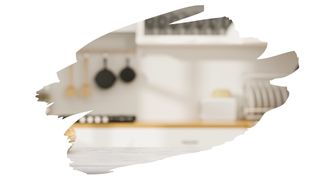Every kitchen countertop should ideally be coated with a water-resistant seal. Especially if the countertop is made from woods that aren’t naturally rot-resistant (such as Birch or Maple wood).
Related Post: A Quick Beginners Guide To Rubberwood Vs Birch Wood [For A Butcher Block Countertop]
And a quality sealer can do more than simply prevent water-damage. It can also protect wood from heat-damage and scratches too.
But, not all wood finishes are created equal when it comes to sealing kitchen surfaces.
So, if you had to choose between polycrylic or epoxy, which one’s better for your kitchen?
Well, in this post, you’ll learn why Polycrylic is only used for interior wood — and why this can also impact it’s effectiveness in kitchen environments. You’ll also find out what epoxy’s ‘compressive strength’ is — and how it relates to this substances incredible scratch-resistance.
And keep reading to discover which one of these two popular wood sealers is best for your homes countertop…

This post may contain affiliate links to products that we receive a commission for (at no additional cost to you). Learn more here.
What Is Polycrylic Usually Used For?
Well, Polycrylic is a water-based sealer (from Minwax) that is primarily used on interior wood.
It offers about the same level of protection as any water-based polyurethane. And it can protect wooden surfaces from scratches and scrapes.
But, it is important to remember that this is an interior sealer. So that means that it’s not ideal for exterior wood or very humid environments.
Is One Coat Of Polycrylic Enough To Seal Wood? You will need to apply at least three thin coats, if you want Polycrylic to really protect wood.
So Can You Use Polycrylic On Kitchen Countertops?
You could… but let’s take a moment to think about how kitchen countertops are used.
Kitchens are steam-filled spaces, where a lot of water-spills and moisture can build up. On top of that, it is not unusual to place pots and pans on a kitchen countertop while you move around and prepare food.
Now all of those things — from the steam to the water to the hot pan — can damage a Polycrylic seal.
You see, Polycrylic is water-resistant. However it is far from being the most waterproof wood finish out there. It can handle a bit of water here and there, but not daily condensation and steam.
But, using Polycrylic to seal a tabletop isn’t a problem, because you can use coasters and placemats to protect the finish from cups and plates.
Yet, lining a sealed countertop with protective placemats, kind of defeats the purpose of a protective sealer in the first place.
So, you’ll need a more water-resistant and heat-resistant sealer for a kitchens countertop.
Does Polycrylic Dry Hard? It will if you give it time to dry and cure into a durable solid coat. This water-based sealer will dry fairly fast (in a matter of hours). Yet it will need at least a day to wholly cure. And in colder weather, it will take even longer to dry and cure.
So What About Epoxy? Is It Heat Resistant Enough For A Countertop?
Very much so, especially if you use specially manufactured heat-resistant epoxy.
Regular epoxy sealers can handle temperatures of up to 300°F (150°C) — albeit briefly. However, heat-resistant epoxy can handle temperature levels twice that, of up to 600°F (300°C).
But, it is not only the heat resistance of epoxy that makes it great for countertops. Especially since you likely aren’t going to be using it as a place to rest hot pans.
Instead, it’s fantastic water-resistance is what makes epoxy one of the best sealers you can use in your kitchen.
Wait A Second…Is Hardened Epoxy Really That Waterproof?
It is waterproof in that neither water droplets nor water vapor can sink past it.
Other wood finishes, such as Tung oil or Linseed oil, are microporous. Which means that they allow water-vapor past their coat.
And even urethane-based sealers, like Polyurethane or Polycrylic, can become damaged by enough condensation buildup.
Related Post: Will Polyurethane Prevent Water Rings? (Best Practice Revealed)
And Is Epoxy Solid Enough To Be Good For A Kitchen Countertop?
It is, because once this material hardens, it takes an incredible amount of force to scratch it. And this is all thanks to its high compressional strength.
Compressional strength reflects the amount of pressure it takes to crush any given material.
Epoxy resins compressive strength ranges from 500 psi to 12,000 psi (depending on different application factors). To put this into perspective, the compressional strength of concrete ranges between 3,000 psi to 5,000 psi.
Essentially the greater its compressional strength, the more scratch resistant epoxy becomes.
Plus, thanks to its super-adhesion, you can apply epoxy directly onto solid wood, marble, or even laminated countertops.
But Is Epoxy More Scratch Resistant Than Polycrylic?
Yes, but only because they both resist scratches in slightly different ways.
Epoxy is scratch-resistant because it is so rigid and hard.
While urethane-based sealers like Polycrylic, have a fair bit of ‘give’ to them. So they tend to absorb pressure, as opposed to cracking under it.
Can Polycrylic Be Used Over Epoxy? As long as that epoxy has had time to properly dry and cure, then Polycrylic will adhere to it.
To Wrap Up, Here Are The 3 Key Takeaways From This Post…
- 1). Polycrylic is a water-based sealer ideally suited for interior wood. Nevertheless, it should not be used in areas that experience high levels of humidity, splash-back, or steam.
- 2). Polycrylic can be used to seal a kitchen countertop. However, the seal may become damaged due to the typical steam-filled cooking environment of a kitchen.
- 3). Epoxy is more water-resistant and heat-resistant than Polycrylic. It is a better choice for sealing kitchen countertops.
References:
Network formation in curing of epoxy resins | SpringerLink



